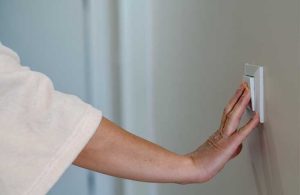If you are a caregiver for an individual who suffers from any form of dementia, you know and understand there are many challenges. The main one being adapting the individual’s living space in order to accommodate their new and constantly changing needs.
A vast amount of research has been conducted and it has been established that there are several methods for modifying a home in order to make it dementia-friendly. These modifications will help in aiding the patient’s memory, offer them higher levels of independence, and will drastically reduce their risk of falling. In this guide, you will be provided with information on the main elements of designing spaces for an individual with dementia.
 Lighting
Lighting
Lighting is a critical component when creating a dementia-friendly home. First, you should ensure that there is twice as much light in all rooms than there normally is in a standard home. The curtains should be kept open during the daytime times. You should place a focus on incorporating as much natural lighting into the home as possible.
As the day progresses, lighting should be dimmed so that it helps the natural circadian rhythm of the patient which allows for them to wind down as bedtime approaches. Incorporate lights that provide a “home” feeling and not large overhead lights that may result in the patient feeling as if they are in a hospital or institution.
Utilize Colors and Focus on Contrast
Colors and the utilization of contrast help in seeing much better. Seeing is important for the dementia patient. Not only will the proper use of color and contrast help in improving sight, it also helps in drawing attention. Follow the tips below to make the best use of color and contrast within the home:
- First, evaluate all switch plates. If they are the same colors as the walls, change them to a brighter color – such as green or red. Then, label them and make sure to include stickers of the directions of “on” and “off”.
- Label doors, cabinets, drawers, and other areas with photo images, cards, and labels.
- If possible, label hot and water faucets. You may want to include images such as ice and fire to make it easier for the patient to understand the differences between hot and cold.
- Utilize color and contrast on items that are commonly used. Examples include telephones, remote controls, and other items. For the telephone, you may want to purchase one that adds pictures of loved ones and program the person’s phone number in on the associated button.
- Place dark-colored rugs in front of doors so that the patient is less likely to go outdoors when it would be unsafe to do so. If you must take the individual out, remove the rugs. Many with dementia will not step across dark-colored spaces.
- Keep the patterns used on the walls, floors, and furniture simple. Avoid wavy lines and stripes. Floors should be a solid, neutral color in all rooms.
Conclusion
By using lighting, color, and contrast, you can create a home that is safe for a dementia patient. As the condition progresses, the patient should have someone with them at all times. If this is not possible, memory care is a productive solution. To learn more about memory care services for dementia patients, contact us here at Beacon Senior Advisors by calling: 973-713-0096 or visit us at www.BeaconSeniorAdvisors.com.